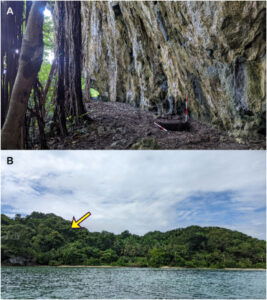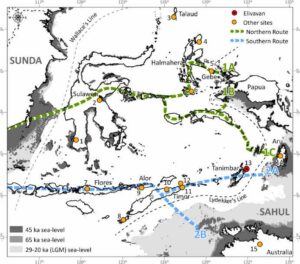Newly discovered evidence suggests that 42,000 years ago, ancient humans likely used various forms of maritime capabilities, an advanced form of technology for the period in which it was used, to traverse the world’s oceans.
In Southeast Asia, new evidencs points to the use of watercraft that allowed ancient sailors to colonize a portion of the more than 13,000 islands that make up modern day Indonesia, including the remote Tanimbar Islands.
“The question of how our early ancestors arrived there from Southeast Asia is one of the most captivating in prehistoric migration, mainly because of the vast distances covered and advanced seafaring skills that would have been required,” explained Mr. Hendri Kaharudin, a PhD candidate at the Australian National University (ANU) and the lead author of the study outlining the advanced maritime technologies employed by these early sailors that helped them reach the Tanimbar Island of Elivavan.
“This discovery marks one of the southern route’s earliest known sites, making it a crucial piece of the puzzle,” Mr. Kaharudin added.
42,000 Years Ago, the First Human Migrants Sailed to Tanimbar
While scientists have often theorized about the first arrival of human migrants in Indonesia from Southeast Asia, no concrete theory is universally accepted. According to the team’s research published in Quarternary Science Reviews, recent discoveries made on the Indonesian Tanimbar island of Elivavan revealed that people first arrived there around 42,000 years ago.
“Along with tiny fragments of pottery, we also found evidence of things like bones, shells, and sea urchins that point to the island’s role as a hub for early maritime activities,” Mr. Kaharudin said.


To reach this remote location, ancient mariners would have had to traverse exceedingly long distances over treacherous seas. Mr. Kaharudin said these ancient mariners would have had to traverse bodies of water over 100 kilometers in the distance “regardless of their direction of travel.” According to the press release announcing the new findings, “the risky nature of the sea crossings suggests the colonists had developed advanced maritime technology by around 42,000 years ago.”
The Debrief previously reported on discoveries showing that Stone Age sailors from 7,000 years ago employed some advanced nautical techniques to sail long distances. However, this research is the first to identify similarly advanced techniques from tens of thousands of years earlier.
Mystery of Ancient Routes Potentially Solved
If the discoveries made on Elivavan ultimately confirm the first route to Indonesia taken by ancient mariners over 42,000 years ago was a southern one, it will solve a long-standing debate between scientists about which route these original colonists took to get there.
“There are two main routes that have been explored as possibilities since the mid-20th century, a northern path via islands like Sulawesi, and a southern track passing near Timor and the Tanimbar islands,” Kaharudin explained. This particular location, which lies along the southern route, is significant, the researcher notes, as “Tanimbar is located just off the ‘Sahul shelf’, which encompasses modern-day Australia, as well as New Guinea.”


To make such a dangerous crossing, the researchers believe that these ancient seafaring humans likely hopped along the coasts, moving from island to island as they slowly spread out. This strategy evolved over time, the researchers note, meaning that the colonization was not a single event but “a gradual process involving successive waves of seafaring populations.”
“Coastal communities likely navigated shorelines, exploiting marine resources and establishing resilient settlements along their journey,” Mr. Kaharudin explained. “This island-hopping strategy facilitated cultural exchange and adaptation, shaping diverse societies across the land mass.”
Studying Remote Locations Could Uncover More About Ancient Human Life
Although the discovery of human occupation on Elivavan of the Tanimbar Islands over 42,000 years ago is significant, the researchers behind the discovery note that there is still much more work to be done. This includes taking a closer look at the area where these discoveries were made to paint a more complete picture of these early seafaring humans. In fact, according to Kaharudin, it is the exploration of these remote locations that could answer the mysteries of ancient human migration.
“As more work is done in lesser-explored regions like the Tanimbar Islands, I expect we’ll uncover more about early human life and migration patterns,” he explained.
Christopher Plain is a Science Fiction and Fantasy novelist and Head Science Writer at The Debrief. Follow and connect with him on X, learn about his books at plainfiction.com, or email him directly at christopher@thedebrief.org.

